Ultimate Peru-Bolivia-Chile Itinerary for 4 Weeks
Peru, Bolivia, and Chile are some of the most visited and beautiful countries in South America. Each of these countries is so diverse that it deserves weeks or even months to be explored on its own. Unfortunately, most of us have limited time and budget, that’s why I came up with the most efficient 4-week itinerary so you can see as much as possible within this limited time.
In this epic South American itinerary I will share some useful tips such as border crossing, money exchange, transportation, safety tips, and much more from my own experience. Traveling in South America, was one of the best trips in my life with unforgettable experiences.
Let’s start with the overview of our 4-week itinerary before we deep dive into the following sections.
Day 1: Lima Arrival (Peru)
Day 2-3 : Paracas – Huacachina
Day 4 – 8 : Cusco – Sacred Valley – Machu Picchu
Day 9: Rainbow Mountain
Day 10-11: Puno and Lake Titicaca
Day 12-13: La Paz (Bolivia)
Day 14-16: Sucre
Day 17: Potozi
Day 18-20: Uyuni, Salt Flats and Flamingos
Day 21-23: San Pedro de Atacama (Chile)
Day 24-25: Santiago de Chile
Day 26-27: Valparaiso
Day 28: Santiago Departure
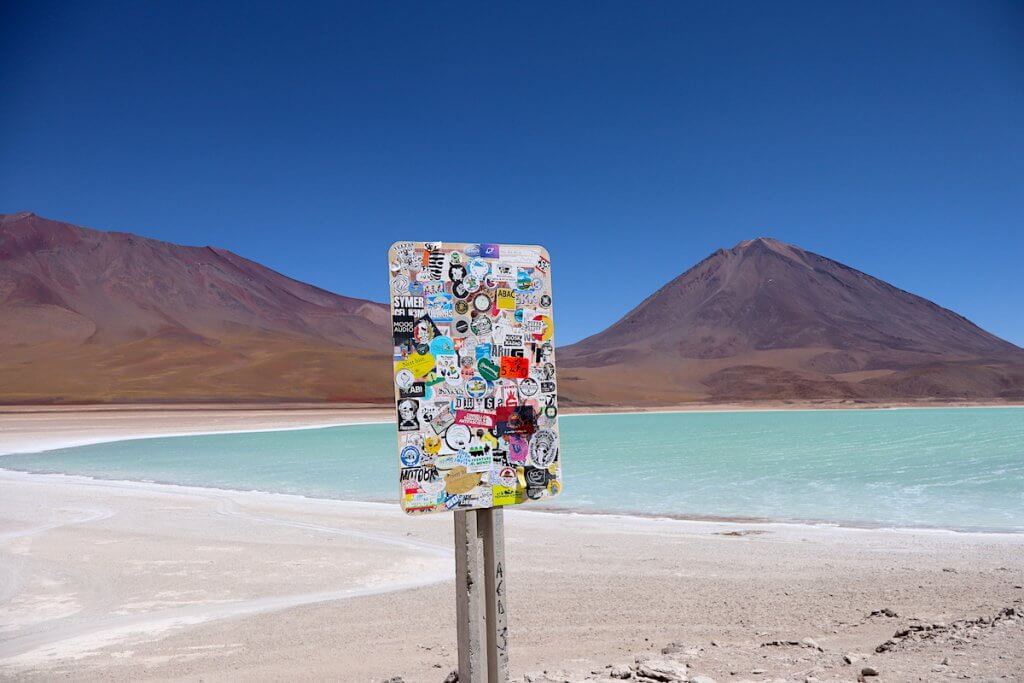
Map of Peru Bolivia Chile Itinerary
Currency Excange
In Peru, Bolivia, and Chile I recommend exchanging money instead of using ATMs if possible. In Peru and Chile, ATM fees will be as high as 10 USD per withdrawal. Never exchange money in the airports, especially in Peru, the exchange rate there is horrible. You can easily exchange USD, Euros, or GBPs in the banks or official exchange houses called Cases de Cambio. Bring some USD in small notes. You can pay for most of the tours in South America with USD.
Local currencies:
Peru – SOL (PEN)
Bolivia – Boliviano (BOB)
Chile – Chilean Pesos (CLP)
Trip Preparation
Health Insurance – when traveling abroad, especially in South America, you should always have travel medical insurance that covers all sorts of emergencies during your trip. I recommend Nomad Insurance (SafetyWing) since it’s very flexible. It works in 185 countries and extends your policy automatically every month so that there is a lower risk of letting it lapse and being without coverage. You don’t need to give your list of destinations in advance either: perfect for last-minute changes of plans which happens often. You can check it out here.
Vaccination – Yellow Fever Vaccination is required for certain parts of Peru and Bolivia, especially the Amazon region.
SIM cards and Internet – eSim was a very practical solution for me when traveling in South America. There was no need to desperately look for physical SIM cards when crossing the border and going to the next country. My eSIM plan from Airalo covered 19 countries in Latin America and provided gigabytes of data. I had an internet connection in the middle of the Atacama Desert in Chile and the middle of the Uyuni salt flats in Bolivia. You can check if your smartphone supports it here
Transportation
I recommend the following means of transportation for moving between destinations on this epic 4-week South American adventure.
Airplane (LATAM Airlines)
Domestic flights in South America are quite affordable and frequent, making them a good alternative to long and tiring night buses. LATAM connects most of the South American cities and offers frequent flights. Book your tickets in advance to get the best prices. I recommend taking domestic flights to the following destinations on our South American epic itinerary:
Lima – Cusco (Peru)
La Paz – Sucre (Bolivia)
San Pedro de Atacama – Santiago de Chile (Chile)
Public Buses and Trains
Public buses connecting cities between Peru, Bolivia, and Chile are pretty comfortable. Most of them have air conditioning and extra space to stretch your legs. They even have special curtains for your privacy. This way you can save money on car rental. The following destinations can be reached easily by public buses or trains:
Lima – Paracas
Ollantaytambo – Machu Picchu (Inca Rail)
Cusco – Puno
Puno – Copacabana
Coppacaba – La Paz
Pro Tip: You can take a day trip from Lima to Paracas and Huacachina where transportation will be included. This way you can save some time and enjoy the nightlife of Lima.
Private Transfers or Tour
The following destinations can be best explored either by car, private transfer, or a tour:
Lima
Sacred Valley and Rainbow Mountain
Around Puno and Lake Titicaca
La Paz
Sucre to Potosi
Uyuni and Salt Flats
San Pedro de Atacama
You can use Uber in Lima or just catch a taxi on the street. The prices are affordable. Inside Sucre or Potozi you won’t need any transportation because the cities are quite walkable, but you would need a car for day trips.
Peru: Day 1-11
Usually, 10-11 days is the absolute minimum to see the most popular attractions of Peru such as Machu Picchu, Sacred Valley, and Lake Titicaca. However, if you want to include national parks (i.e.Huaraz) and the Amazon jungle in your itinerary, then you should spend at least 3 weeks in Peru.
Day 1: Lima (161 m/ 528 ft)
Start your day in Lima by exploring the historic district of Miraflores, known for its beautiful parks and coastal views. Visit the Larco Museum to delve into Peru’s rich pre-Columbian history, and then stroll along the iconic Malecón de Miraflores for breathtaking views of the Pacific Ocean. For lunch, go to Surquillo Market in Miraflores to try world-famous Peruvian street food in Lima.
You should try the Peruvian national dish, ceviche, made with fresh seafood marinated in lime and spices. In the afternoon, venture to the historic center of Lima, a UNESCO World Heritage site, to marvel at the Plaza Mayor and the stunning architecture of the Cathedral of Lima. Wrap up your day by enjoying a traditional Peruvian dinner in Barranco, a bohemian district known for its vibrant nightlife and artistic atmosphere.
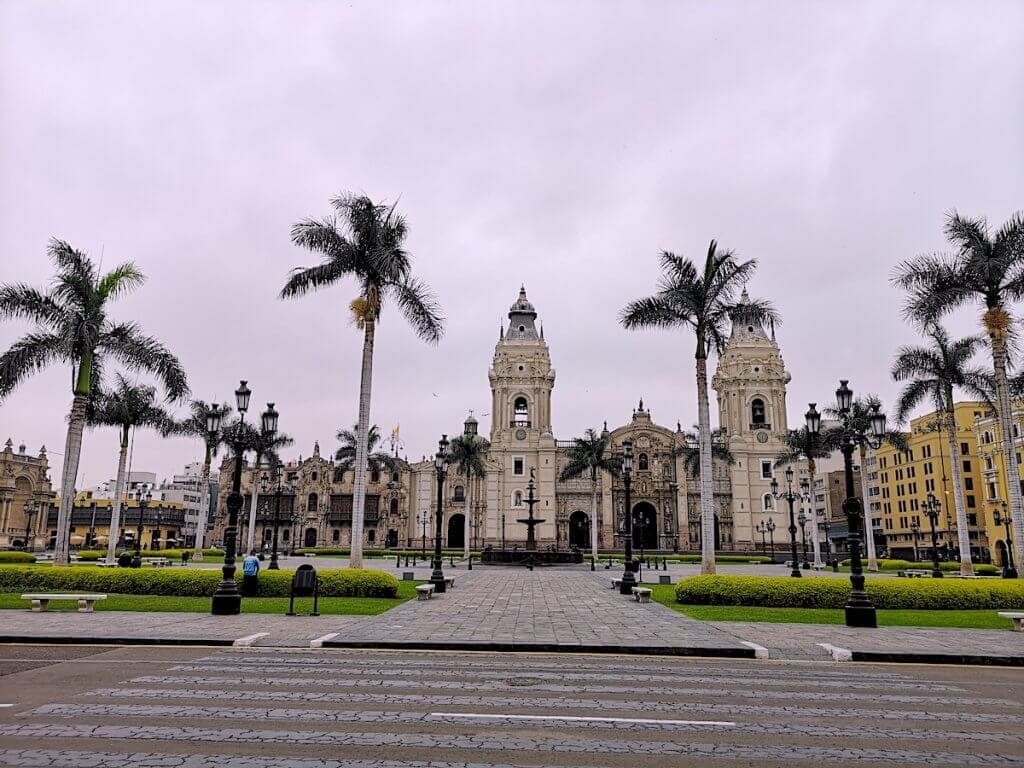
Day 2-3 : Lima – Paracas – Huacachina – Lima
Paracas National Reserve, located along the Peruvian coast, is famous for stunning coastal scenery and diverse wildlife. It is a protected area with the highest concentration of seabirds anywhere in the world. Spend a day exploring the otherworldly landscapes, including the famous red sand beaches and the dramatic cliffs overlooking the Pacific Ocean. Take a boat tour to the Ballestas Islands also known as the “Poor Man’s Galapagos” to witness an incredible variety of wildlife, including sea lions, penguins, and diverse bird species.
To get to Paracas from Lima, the most convenient way is by a scenic bus ride, which takes around 4-5 hours, or a day tour from Lima. Once in Paracas, consider trying fresh seafood at the local restaurants. In the evening enjoy the stunning sunset over the Pacific Ocean with a glass of wine or pisco sour, the national drink of Peru.
Next day head to Huacachina, the unique desert oasis in Peru located near the city of Ica about 1 one-hour drive from Paracas. It is Famous for its towering sand dunes surrounding a small lagoon. You can enjoy activities such as sandboarding down the dunes, taking exhilarating dune buggy rides, and appreciating the stunning sunsets over the vast desert landscape.
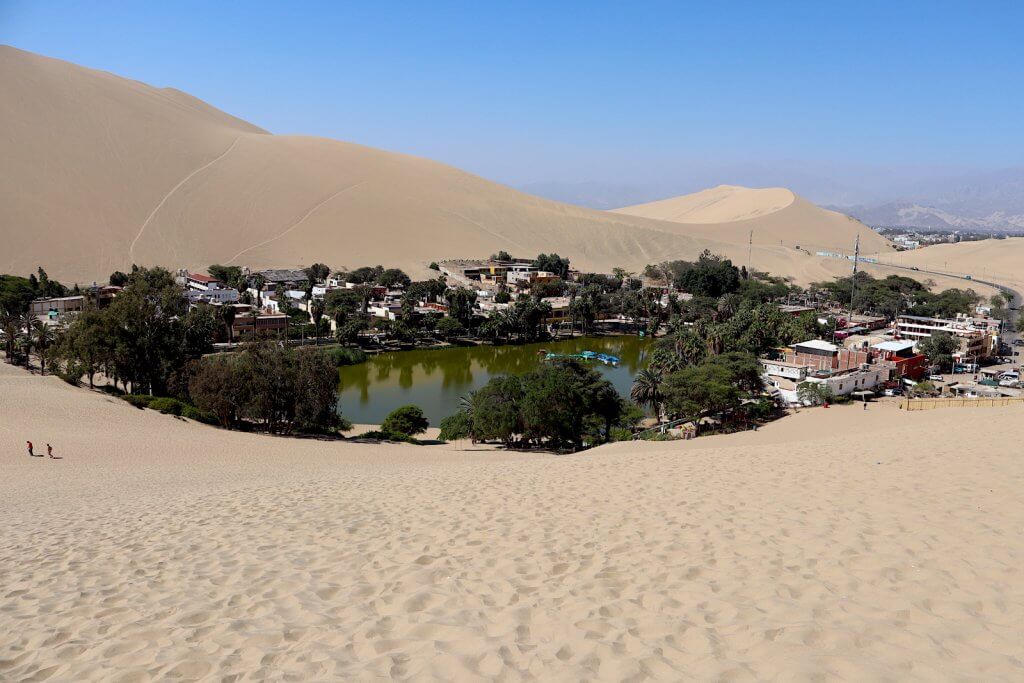
Day 4-5: Cusco (3.400 m/ 11155 ft)
Cusco is the most visited city in Peru after Lima with beautiful Spanish colonial architecture and rich Incan heritage. Due to its altitude at 3400 m above sea level, you would need at least two days in Cusco to acclimatize before planning any hikes.
Begin your first day exploring the historic center, Plaza de Armas, and the Cathedral of Santo Domingo. Dive into Inca history with a visit to the Qorikancha, the Incan Temple of the Sun.
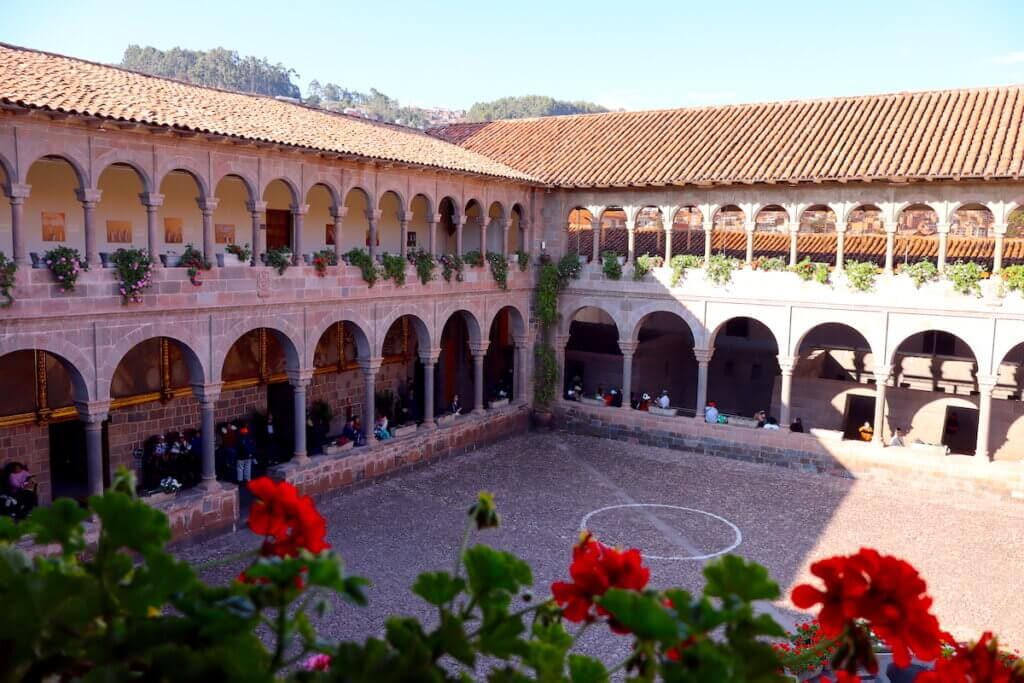
Next day visit fascinating Incan ruins in the outskirts of Cusco Sacsayhuaman, Puka Pukara, Qenqo, and Tambo Machay. Get the best views over Cusco from Plaza San Cristobal.
Day 6 : Cusco – Sacred Valley( Moray-Maras) – Ollantaytambo (2800 m/ 9185 ft)
Sacred Valley with its rich Incan heritage is considered to be the getaway to Machu Picchu.
Start your exploration in Pisac, known for its vibrant market where you can find traditional crafts and textiles. Then travel about 2 hours to Moray near Maras village known for its unique circular terraces built by Incas which is believed to be an ancient irrigation system. Then finish your day in Ollantaytambo, the best-preserved Incan town and a smaller and more authentic version of Cusco. This is very the famous train to Machu Picchu leaves from.
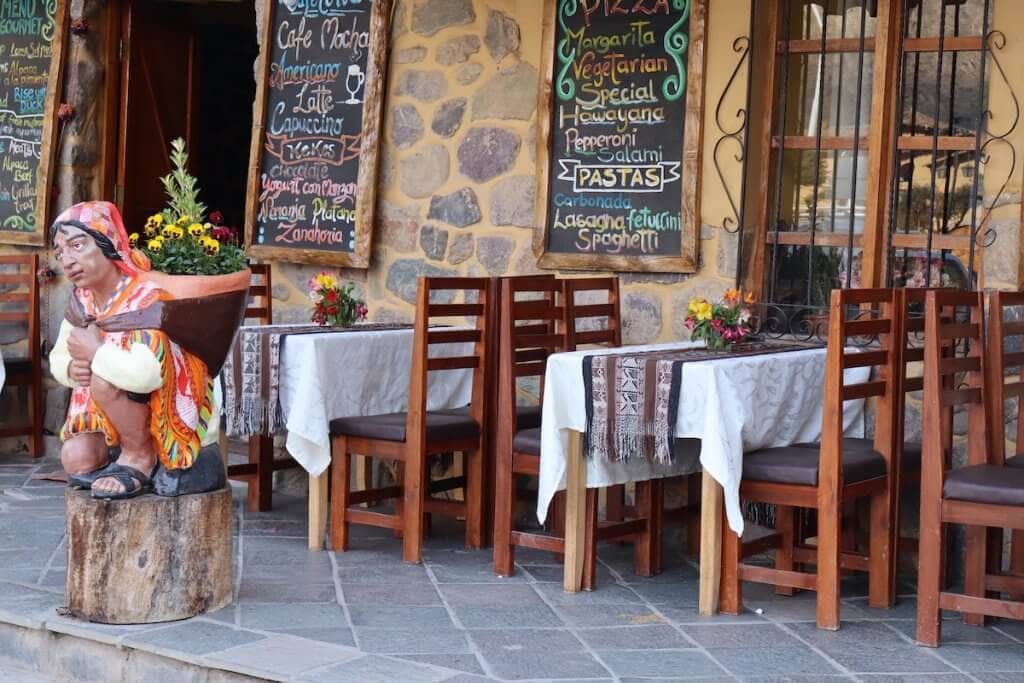
Day 7: Ollantaytambo – Machu Picchu ( Inca Trail Day 1) – Aguas Calientes
There are several ways to get to Machu Picchu from the Ollantaytambo and Sacred Valley. You can either go there directly on a day trip by train and the bus or hike to Machu Picchu. If you opt for hiking then you need to choose between the Classic Inca Trail (4 days, 3 nights) or the Short Inca Trail. I personally did the short version of the Inca trail which was only 2 days and one night. If you want to do the Classic Inca Trail, then you need to stay longer in Peru and see fewer things in Bolivia and Chile if you only have 4 weeks in total for your adventure.
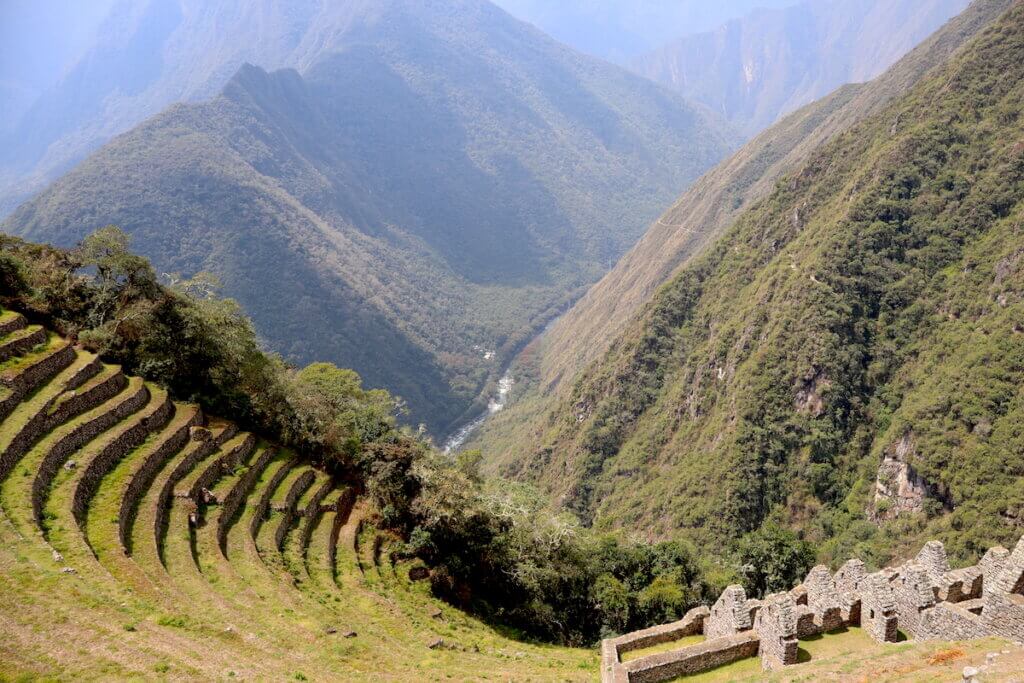
You can find the full description of the Short Inca Trail in my blog post.
Day 8: Aguas Calientes – Machu Picchu (Inca Trail Day 2) – Cusco
After staying the night in Aguas Calientes also known as the Machu Picchu village, get up as early as possible to visit the Lost City of Incas. There is a regular bus from Aguas Calientes to Machu Picchu which takes about 25-30 minutes to get to the entry point. You can enjoy panoramic views during the ride. I highly recommend visiting Machu Picchu very early in the morning to be able to avoid the tourists. Later the day it will get very crowded, especially during the high season between June and August. It is open every day from 6 am to 5 pm throughout the year.
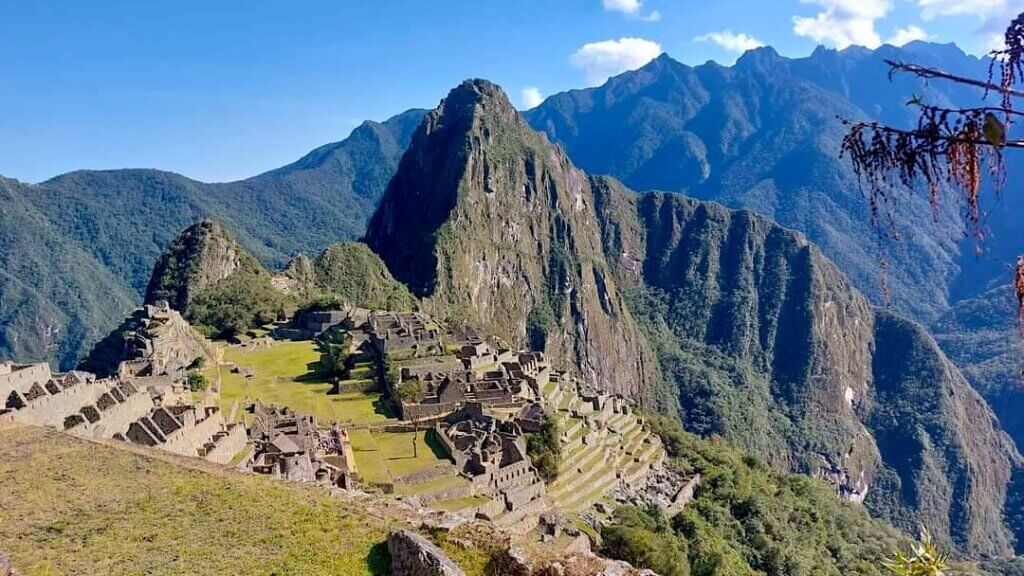
After visiting Machu Picchu head back to Cusco and stay there overnight. Cusco is the central hub in the region well connected via air and extensive bus networks to main cities in Peru and Bolivia.
Day 9: Cusco – Rainbow Mountain (5200 m / 17060 ft) – Cusco
There are several rainbow mountains in Peru but the most visited one is Vinicunca at the altitude of 5200 meters located about 2,5 hours drive from Cusco. The hike is only 5 kilometers in total, hoverer it is quite challenging due to the altitude. But the good news is that if you get tired and realize you can’t manage it, you can always get a ride on a horse for a few SOLs. Locals realized that it could be a good business model and brought lots of horses to the hiking trail to give rides to tired tourists. There are two parallel treks: one for hikers and one for horses. Rainbow Mountain Trail is one of the most beautiful hikes in South America worth doing if you can manage to handle the altitude difference.
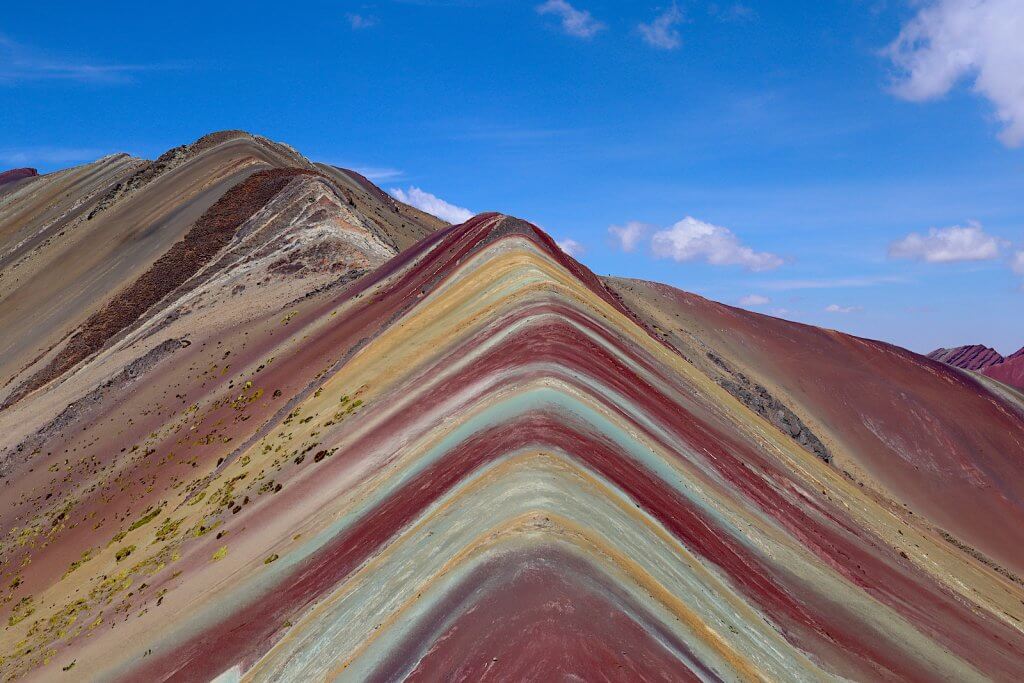
Day 10: Cusco – Puno (3827 m/ 12555 ft)
After visiting Cusco and Machu Picchu, it’s time to head to Puno, the largest town on the shores of Lake Titicaca, and getaway to Bolivia. Several public buses are leaving from Cusco to Puno every day, and the earliest one starts at around 6 am. The fastest bus will take you about 7 hours to arrive in Puno. I traveled with bus company Transzela and was quite happy with the service. Their buses are very comfortable, with enough leg space and air conditioning.
Once you arrive in Puno, explore its small city center, Plaza de Armas, and try traditional Peruvian dishes for dinner such as Quinoa Soup or Alpaca Stew. Be careful with Pisco Sours. At this altitude our buddies are not really able to digest alcohol, so better take it slow.
Day 11: Lake Titicaca
Lake Titicaca, the world’s highest navigable lake, is nestled between Peru and Bolivia, with the Peruvian side offering a rich cultural experience. Lake Titicaca is renowned for its historical significance as the birthplace of the Inca civilization.
Begin your day by visiting the famous Uros Islands, artificial floating tiny islands made of totara reeds, where locals showcase their unique way of life. In the afternoon explore Taquile Island, known for its indigenous communities and intricate textile traditions, offering a glimpse into the region’s rich cultural heritage.
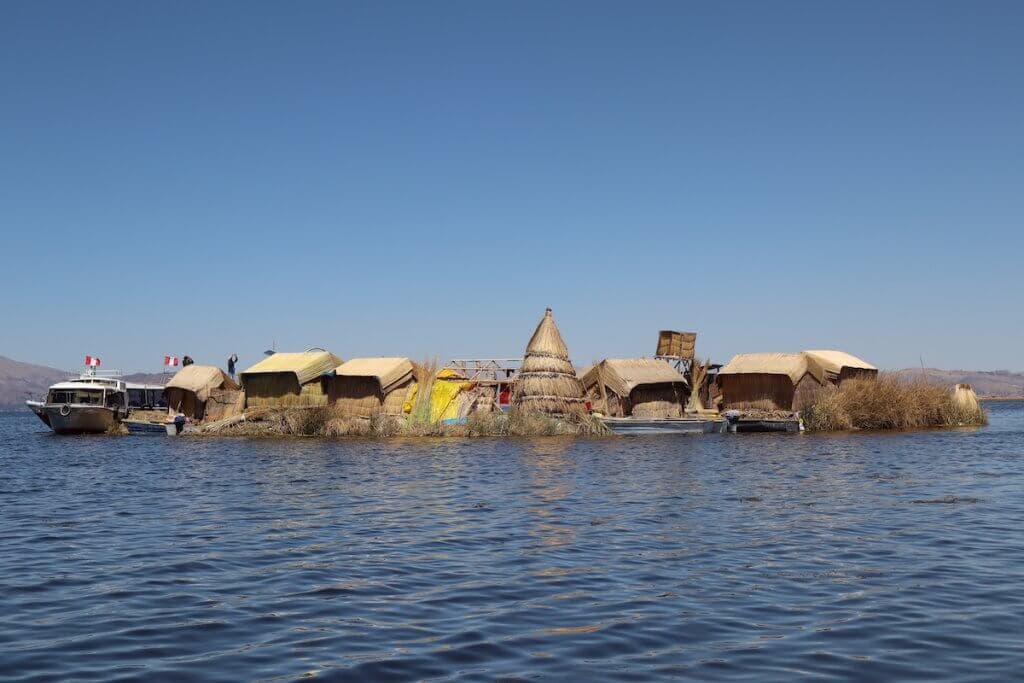
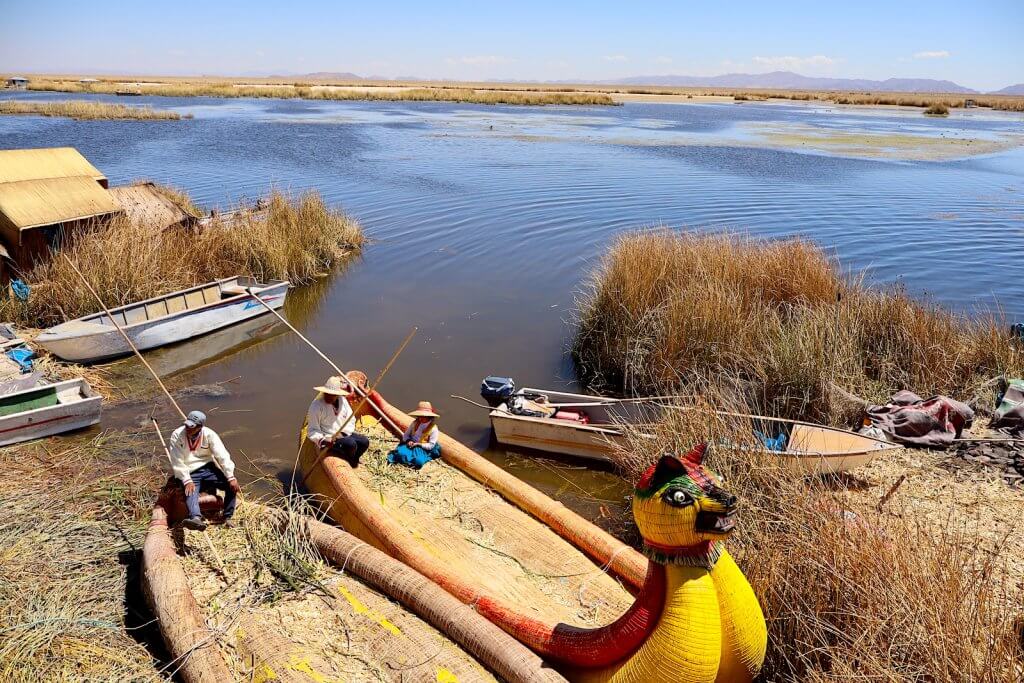
Lake Titicaca Floating Islands
The stunning surroundings, combined with the vibrant traditions of the local communities, make Lake Titicaca a must-visit destination, offering a perfect blend of natural beauty and cultural exploration.
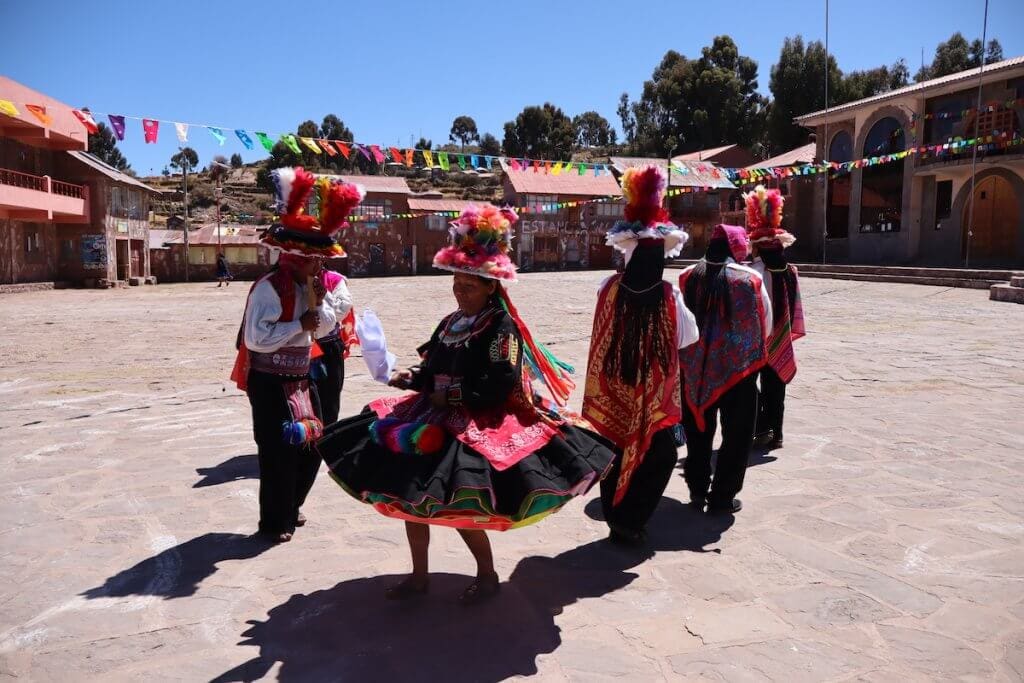
Bolivia: Day 12 – 20
Day 12: Puno – Copacabana (Peru Bolivia Border Crossing) – La Paz
There are several roads connecting Puno to La Paz in Bolivia. The most panoramic one is via Copacabana, the Bolivian city on Lake Titicaca. Puno to Copacabana by bus takes about 4 hours, depending on how long it takes to cross the border in Kasani. Border crossing between Peru and Bolivia is relatively straightforward and most nationalities don’t require visas for Bolivia. Please check with the embassy in your country whether you need a visa or not. All the passengers need to get out of the bus and walk a bit to the passport control point. You should take all your valuables with you otherwise they might get stolen. The bus will be waiting at the Bolivian site.
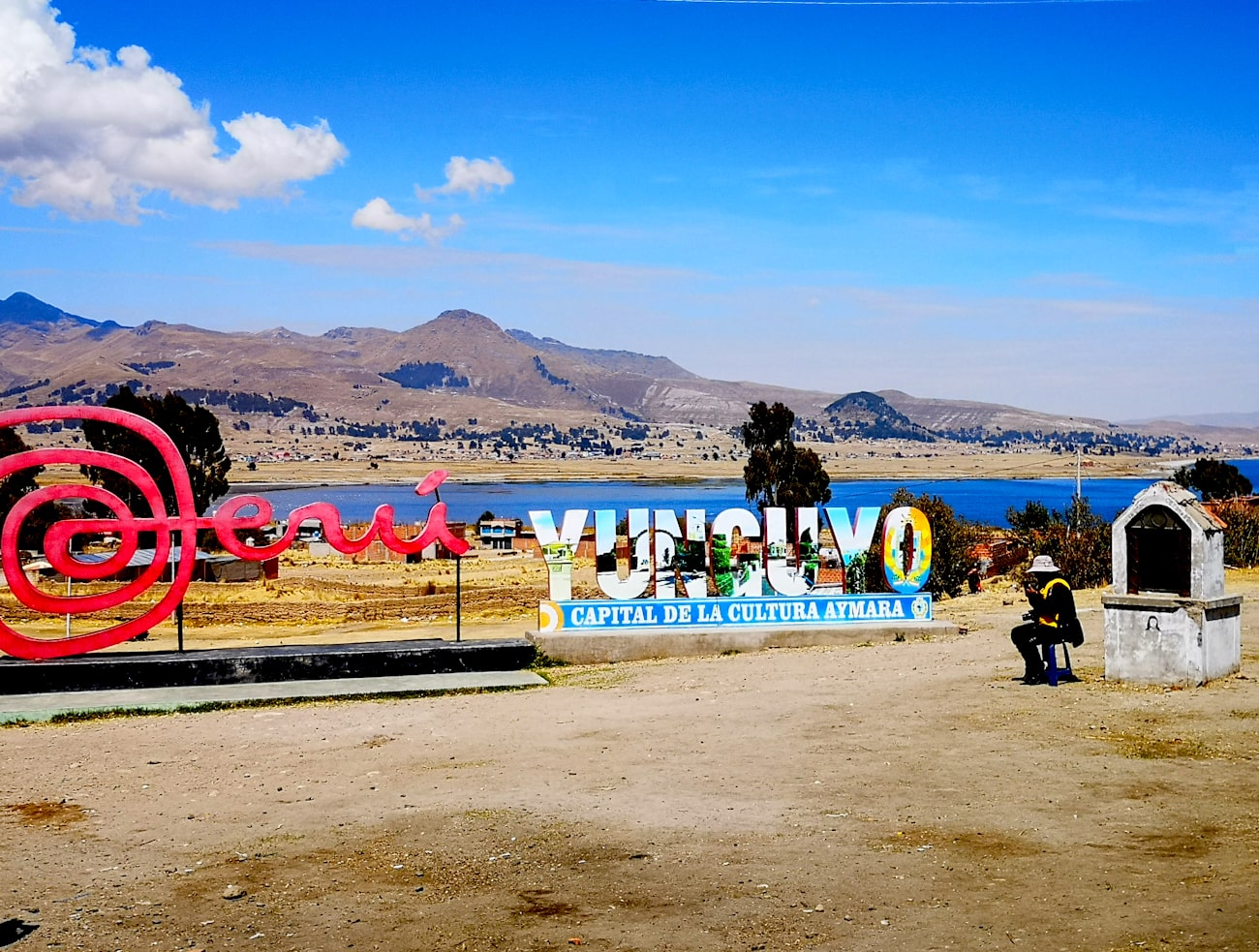
Once in Copacabana, you would need to change to another bus to go to La Paz. The bus leaves on the main square from Plaza Sucre and takes about 4 hours.
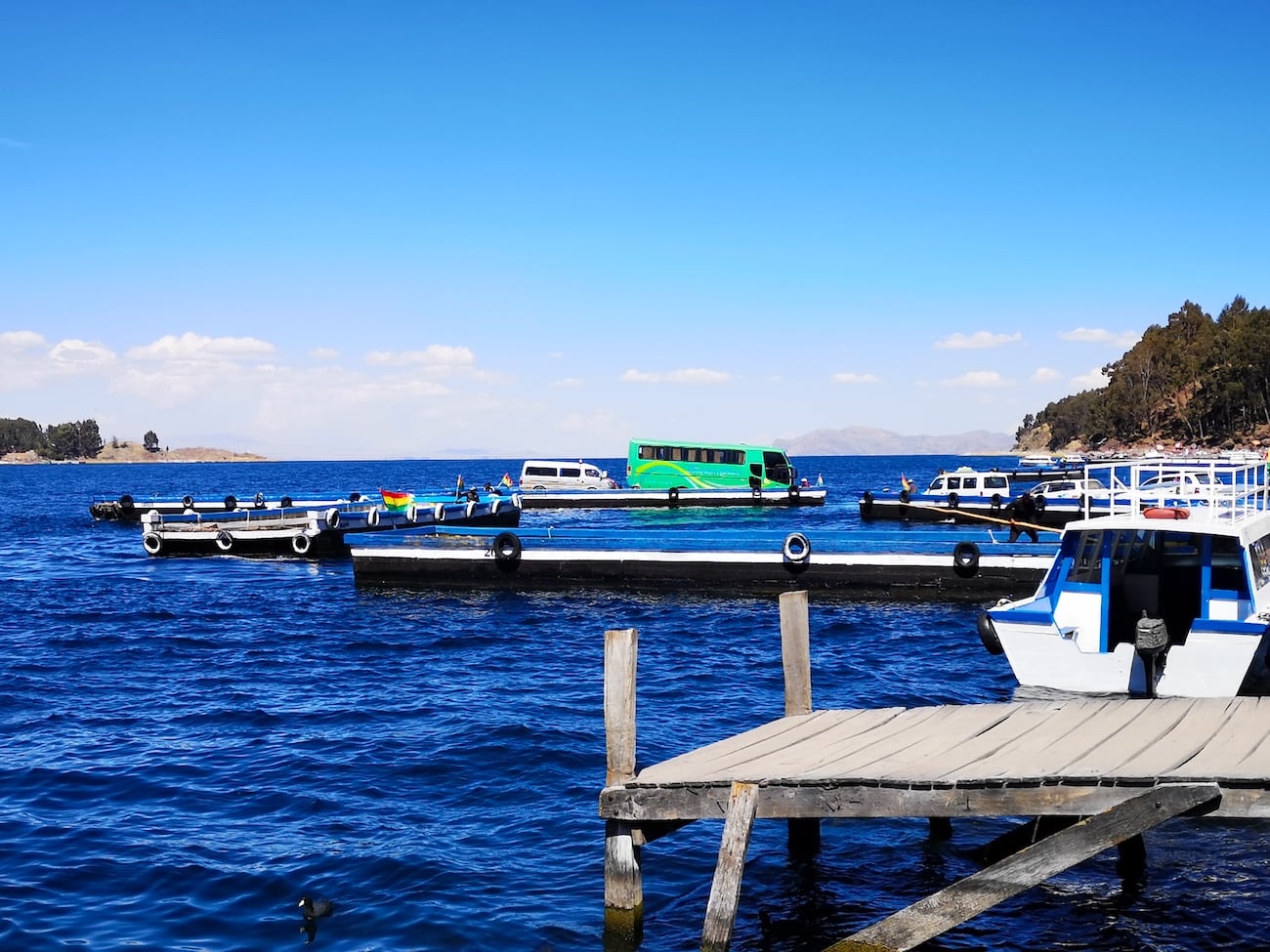
Day 13: La Paz & El Alto (4,150 m / 13,615 ft)
La Paz is the biggest city in Bolivia. I was very surprised to find out that it is actually not the capital of Bolivia. The capital is Sucre, but the majority of the Bolivian government sits in La Paz.
Start your day by exploring the El Alto neighborhood on the hills of La Paz. Check out the weird-looking buildings of the new rich of Bolivia. Here you will find the “Iron Man” building, the “Bumblebee” or the famous “Titanic” building. This neighborhood is not very safe, so you should either rent a car and know what you are doing or take a guided tour.
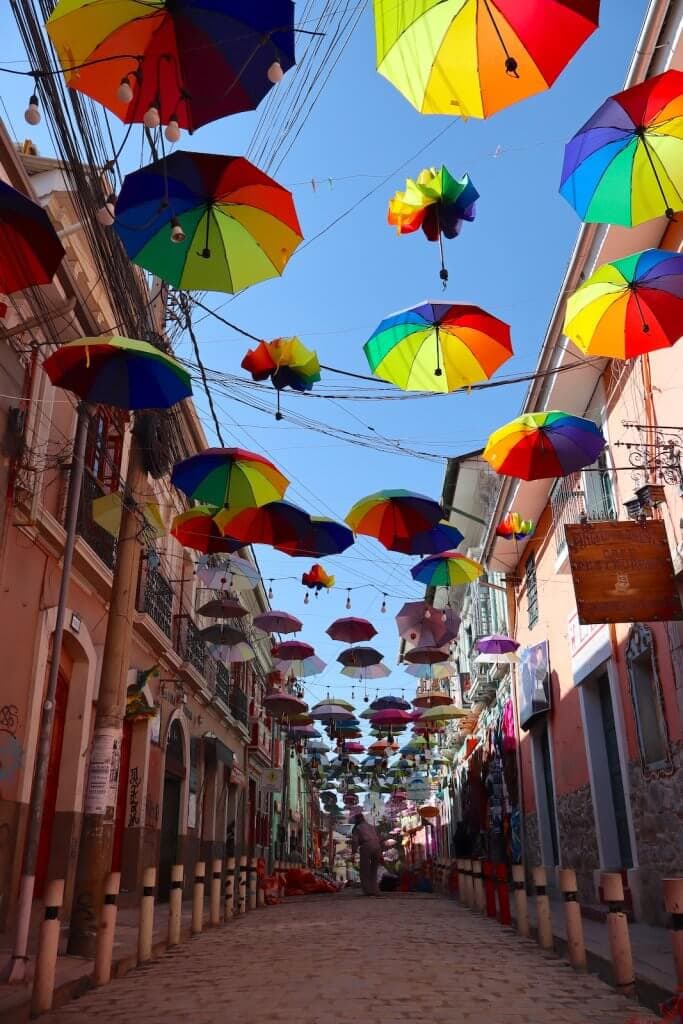
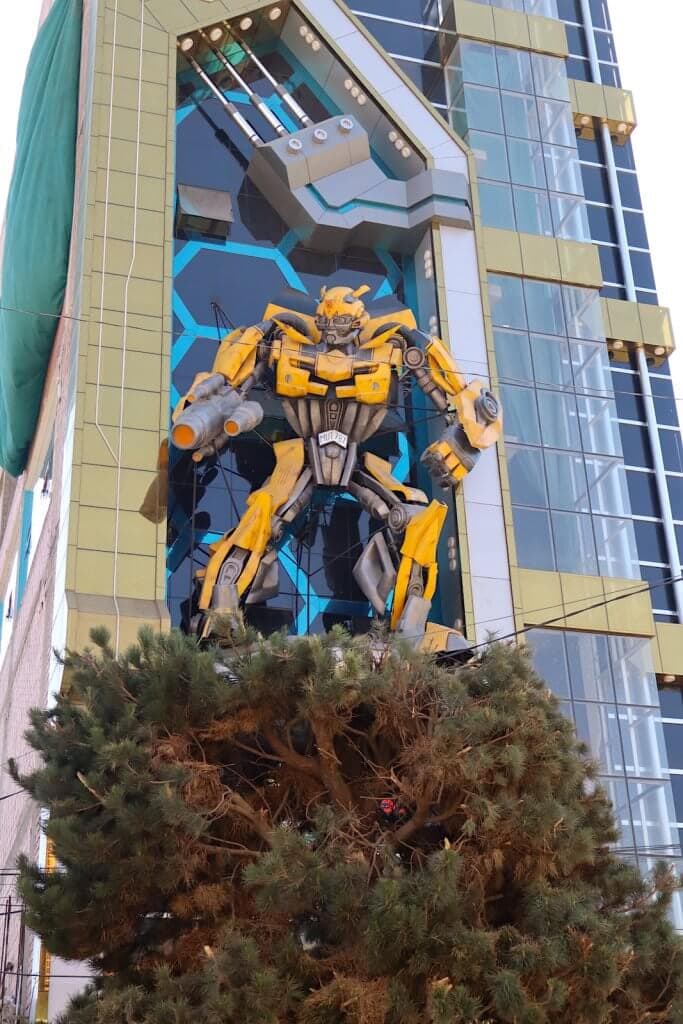
In the afternoon stroll through the witch’s market and buy some souvenirs for half price compared to Peru. Later take a guided tour of the Moon Valley in the outskirts of La Paz famous for geological formations reminding the surface of the moon.
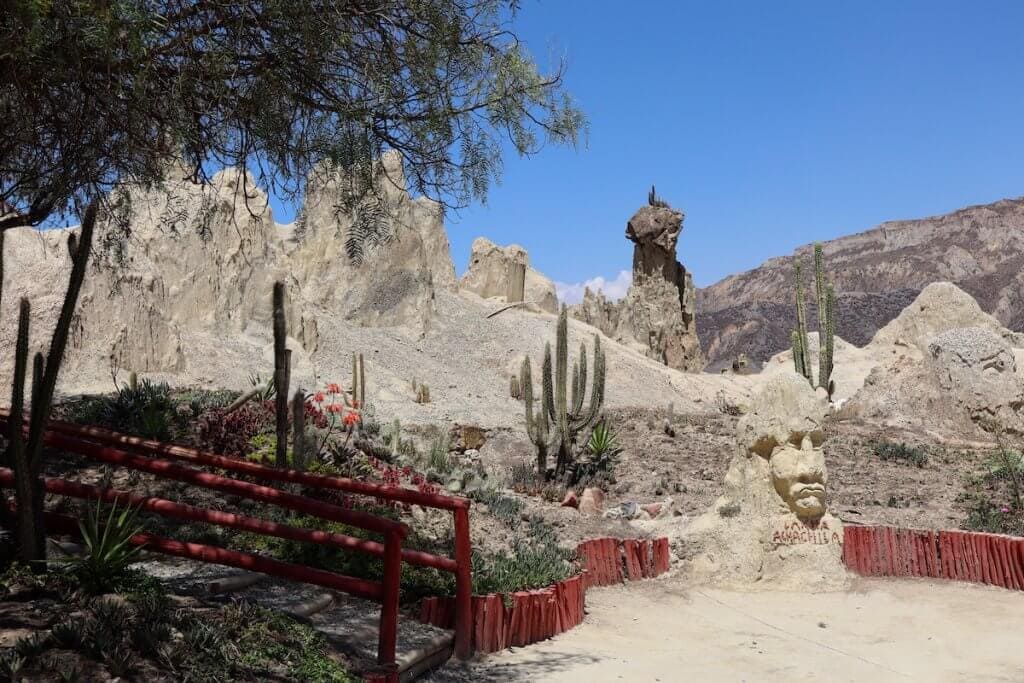
Day 14: La Paz – Sucre
Although there is a public bus connecting La Paz with Sucre, it’s going to be very long and tiring 12 hours. A more convenient but also more expensive option would be a domestic flight to Sucre, plus you will have more time to explore the city.
Day 15-17: Sucre ( 2,790 m / 9,153 feet )
Sucre is one of the most beautiful colonial cities in South America and the capital of Bolivia. Nicknamed “The White City” thanks to its stunning white buildings, Sucre is definitely the hidden Gem of South America. Here you can breathe properly at night because Sucre is located at a much lower altitude compared to La Paz. You can finally enjoy a few drinks and have a good time. I could easily stay a week there and not get bored. It was one of my favorite cities in South America. It felt very safe and clean compared to other cities in Peru and Bolivia.
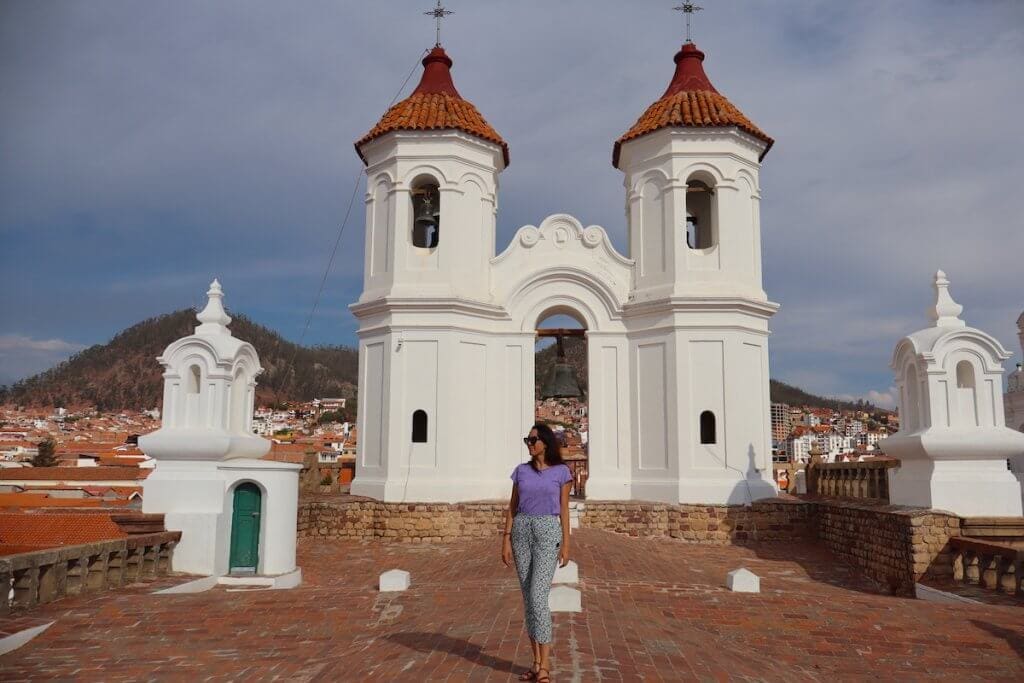
Day 18: Sucre – Potozi
Potosi is conveniently located between Sucre and Uyuni (salt flats). It’s just a 3-4 hour drive from Sucre. If you arrive early, you will have time to explore the famous silver mines of Potosi which have the world’s largest silver deposit.
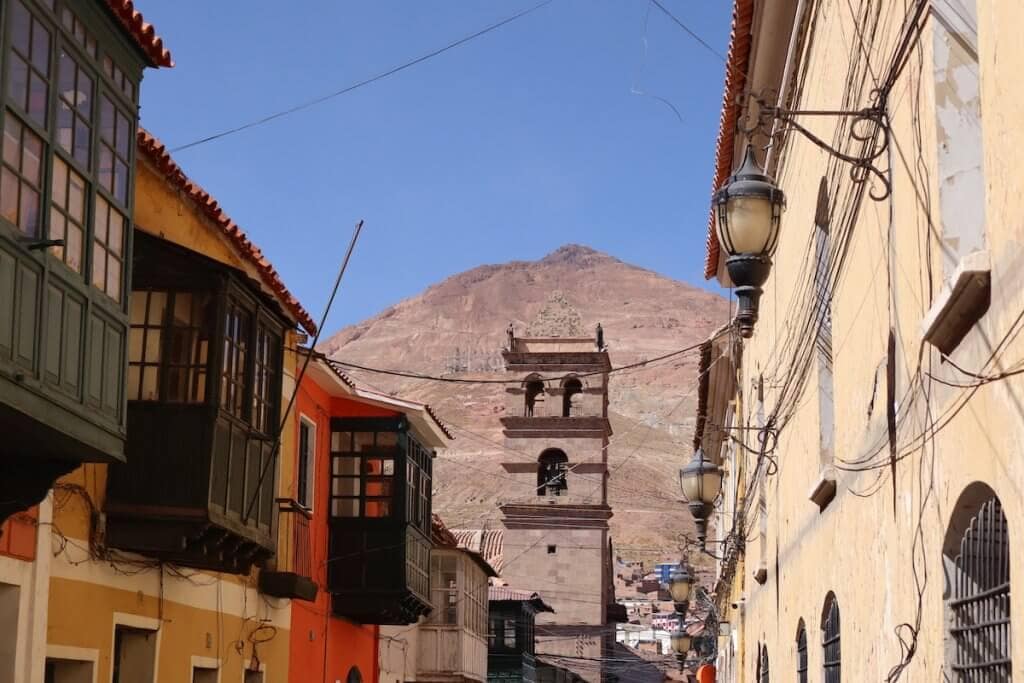
Day 19: Potozi – Uyuni
After staying overnight in Potozi and enjoying your breakfast, head towards Uyuni. On the way make a stop at the Train Cemetery of Uyuni, home to dozens of skeletons of locomotives from the golden era of mining in Bolivia.
Day 20: Uyuni – Salt Flats
Uyuni is a pretty small town and there is practically nothing to see, but it’s the getaway to the famous Salar de Uyuni, the largest salt flats in the world. The best way to explore the Salt Flats is by 4×4 wheel drive. I highly recommend taking a tour instead of driving there yourself. There are no signs and it’s easy to get lost. You are literally in the middle of nowhere and nobody is going to help if you get lost or it’s gonna cost you time and money. There is no shortage of tour operators offering tours on the salt flats and nearby Lagunas with flamingos. The most common ones are 3-day 2-night tours. You can book your tour starting from La Paz, Uyuni, or San Pedro de Atacama. Besides the salt flats, there are many other great things to do in Uyuni and its surroundings.
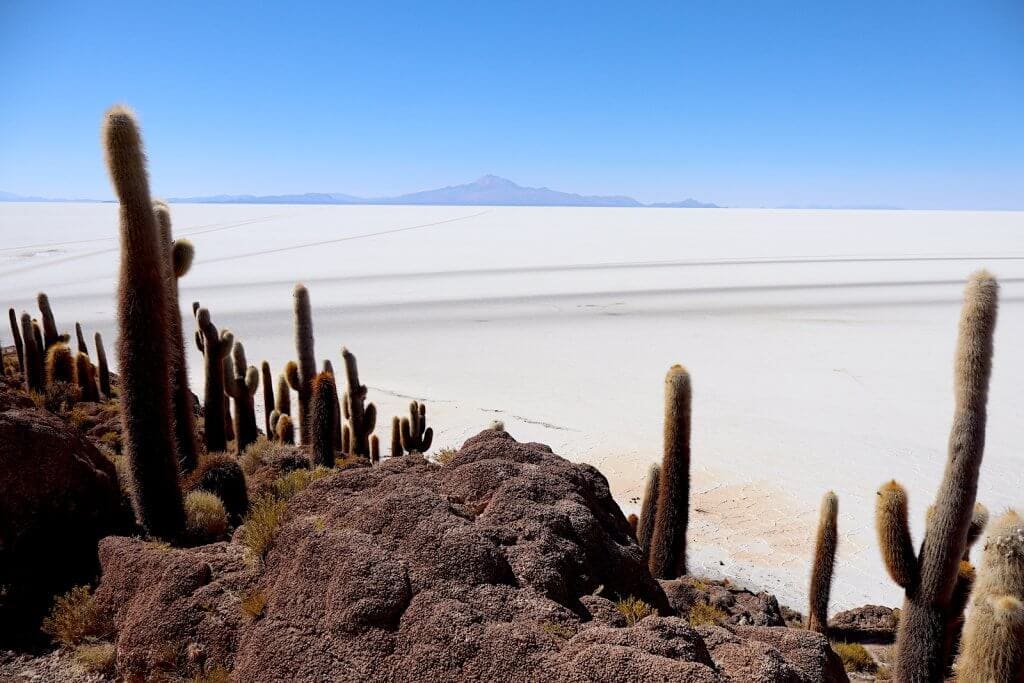
Day 21: Salt Flats – Laguna Colorada & Flamingos
There are many lakes (lagunas) full of Flamingos in the area. They are mostly located close to each other between the Salt Flats of Uyuni and the Atacama Desert. In my opinion, the salt lakes of Bolivia are the best place on earth to watch Flamingos in the wilderness and in their natural habitat. The landscapes are just surreal. The most beautiful Lagunas on the way are:
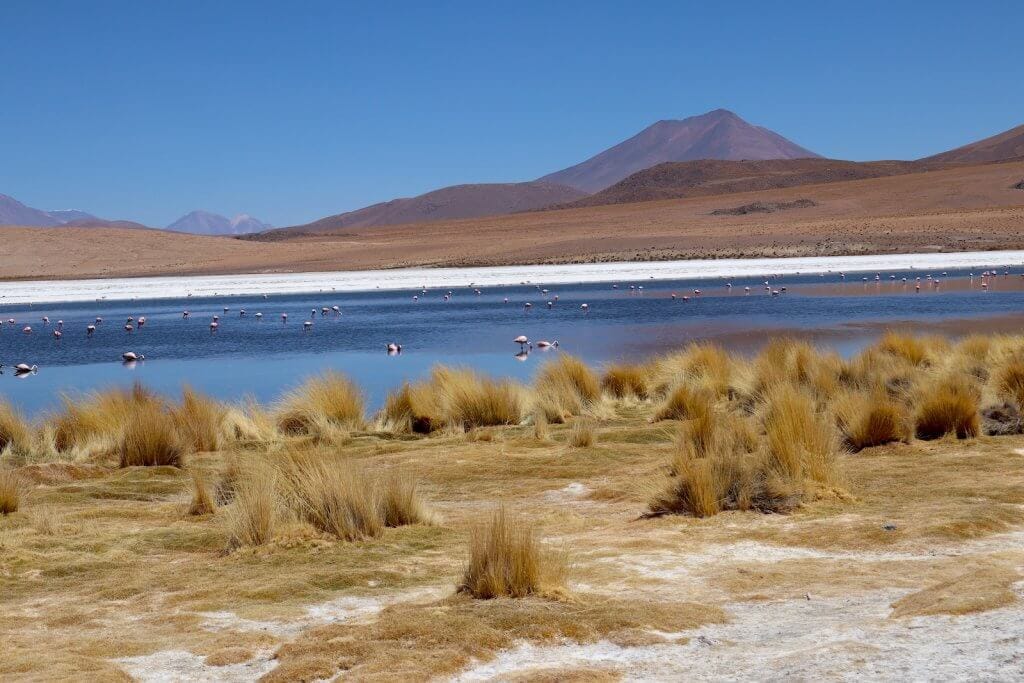
Laguna Cañapa
Laguna Hedionda (Stinky Lagoon)
Laguna Colorada (Red Lagoon)
Laguna Verde ( Green Lagoon)
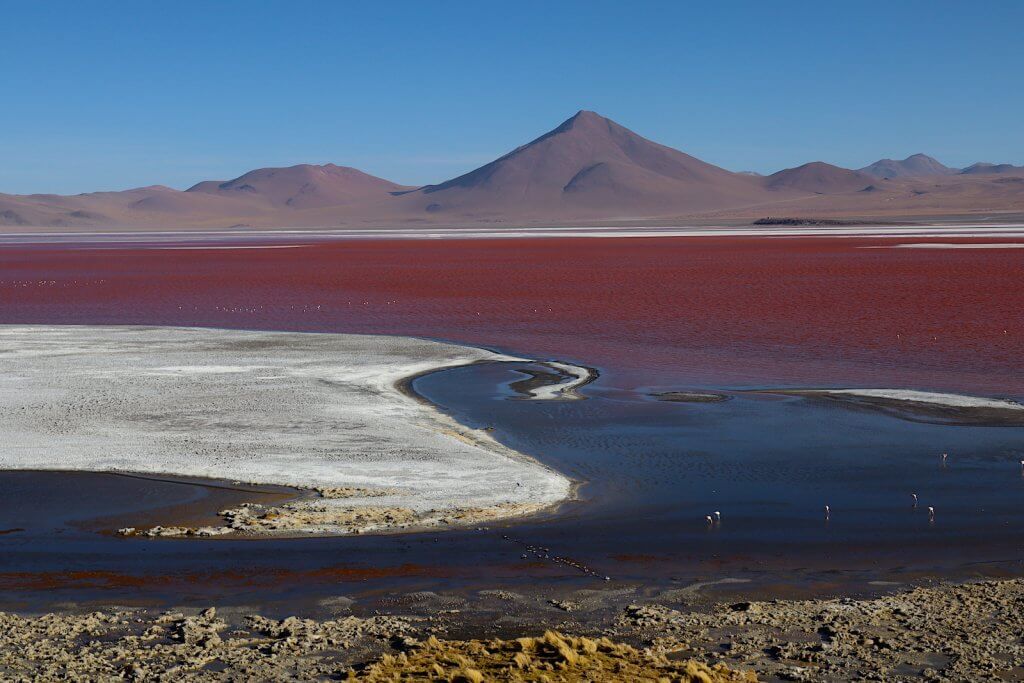
Chile: Day 22-28
Start your day by visiting Sol de Manana Geysers and relaxing in Polques hot springs before heading to the Bolivia-Chile border.
Day 22: Border Crossing Bolivia – Chile – San Pedro de Atacama
Border crossing with Chile was very different from other border crossings in South America where everything is more relaxed. First, we went through the Bolivian Immigration office basically in the middle of nowhere. When we arrived, there was nobody in the immigration office. After our driver did a few calls, finally someone opened the door. The procedure was easy and straightforward. We just had to show our passports and that’s it.
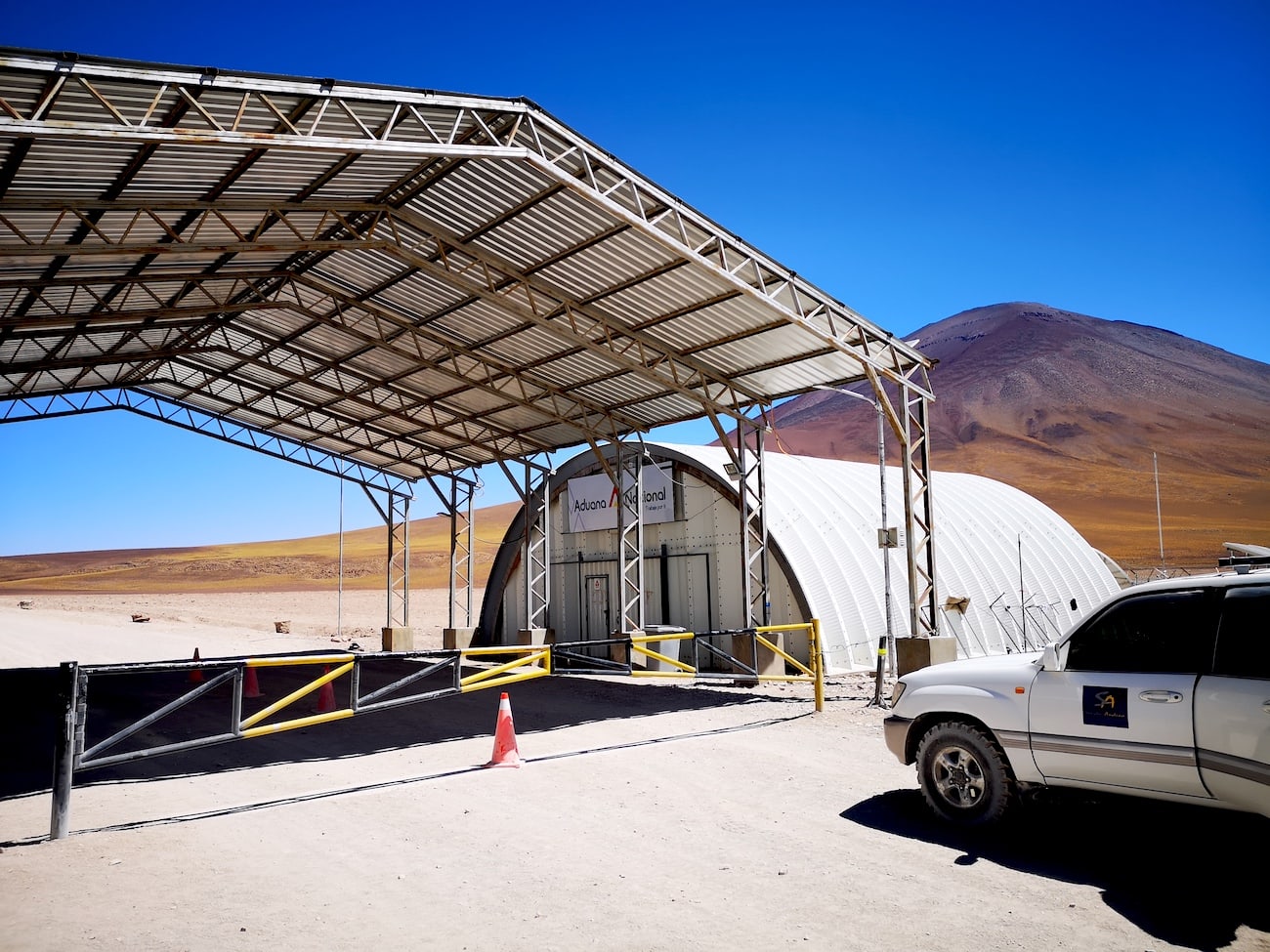
After that, our drivers took us to some abandoned road with the sign “Republica de Chile” and left us standing there with our luggage. After waiting for about 10 minutes, a white mini bus arrived and took us to the Chilean Immigration office. We had to fill out an immigration form and we were not allowed to take any food or drinks. The immigration officers were very polite but also very strict and checked all our luggage. Finally, we got our tourist residence permit “Tarjeta de Tourism” or simply the PDI document. We were informed that we should keep it and would need it later for departure. If we lose it we would have to pay a huge fine.
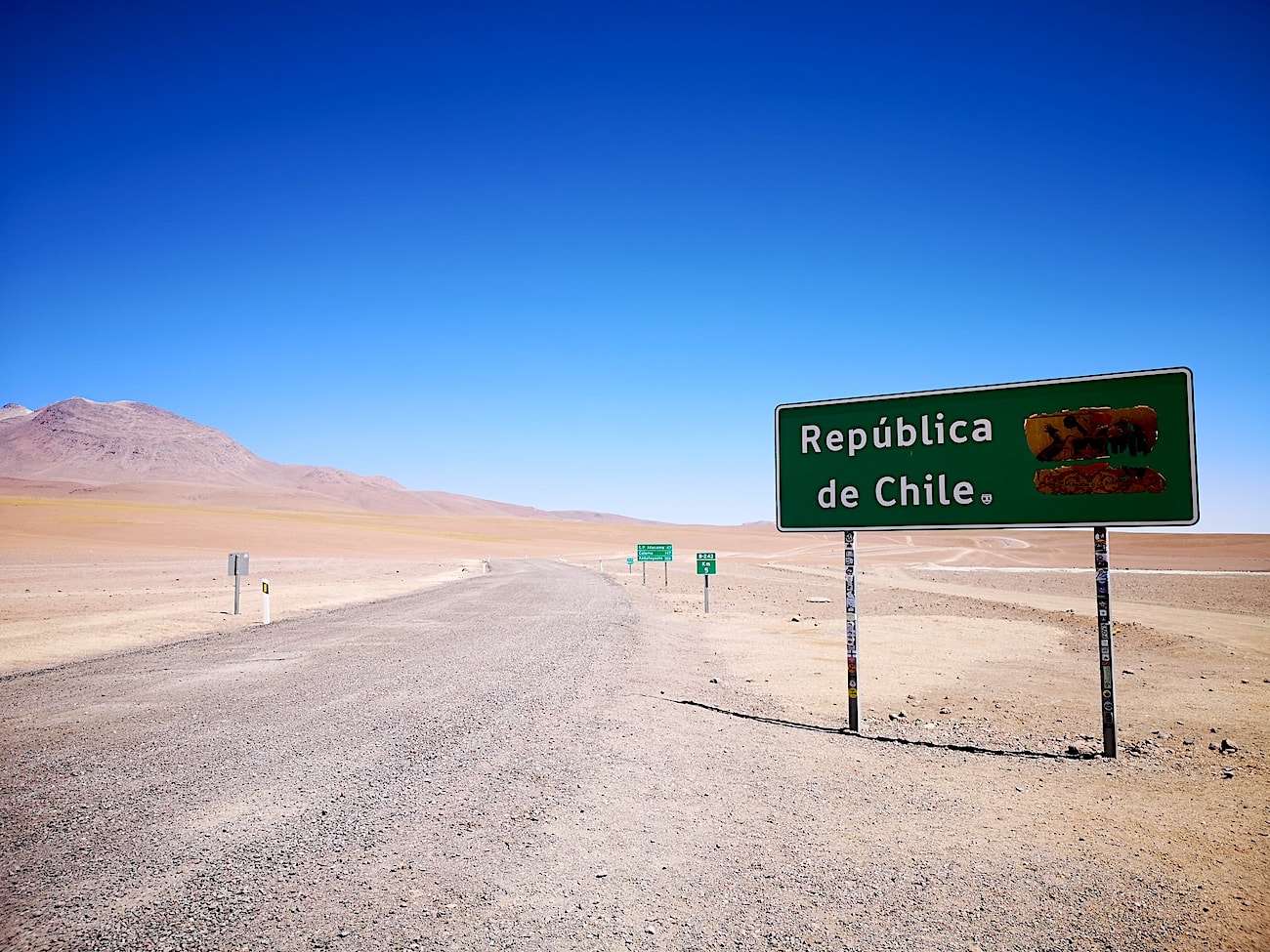
Day 23: San Pedro de Atacama – Moon Valley – Stargazing
San Pedro de Atacama is an artificial city in the middle of a desert built only for tourists.
I was astonished to see beautiful green gardens in the driest place on earth. There is nothing really to see inside the city but there are a few cool bars and restaurants.
Everything in San Pedro de Atacama is extremely expensive. It came as a huge shock for me to find out that food, tours, and souvenirs were 5-10 times more expensive than in Bolivia.
Pro Tip: Buy all the souvenirs in Bolivia. In Peru and Chile, they sell the same things for 2x or 10x the price. If you are into hot springs, go on the Bolivian side instead of the Chilean side. You will pay only 2 USD instead of 60 for the same thing more or less. The facilities on the Bolivian side were excellent and the views breathtaking.
Once you are in San Pedro, one of the first things I recommend doing is taking a guided tour of the Moon Valley in the Atacama desert located about 13 kilometers (8 miles) from the town. Here you will see interesting rock formations, salt flats, and an impressive range of forms and colors. Don’t miss enjoying a spectacular sunset over the Atacama desert which is a once-in-a-lifetime experience.
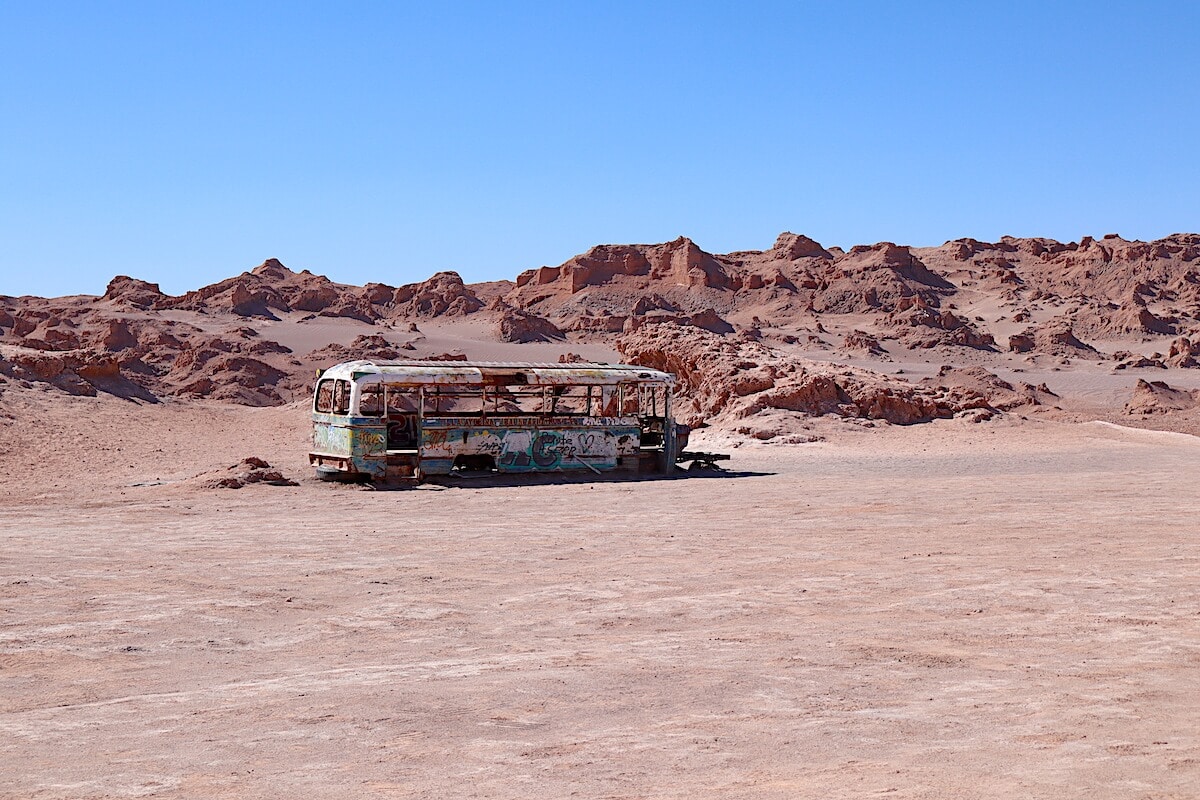
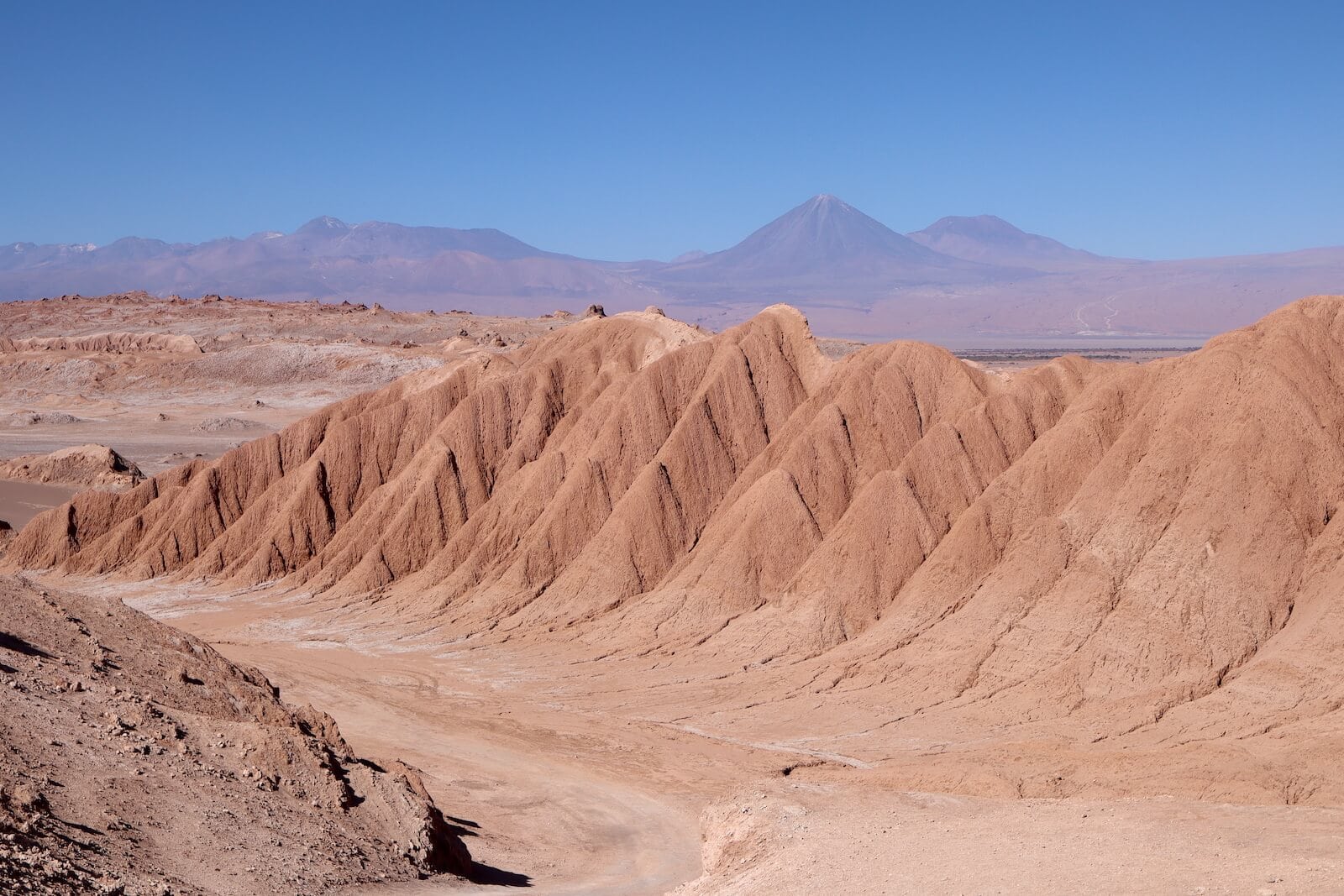
Finish your day by taking a stargazing tour. The Atacama desert is the best place on earth for stargazing because the sky here is very clear. If you take a stargazing tour you will get a short introduction and will be able to see different stars and even the Milky Way with modern cutting-edge equipment.
Day 24: San Pedro de Atacama – Santiago de Chile
To catch the flight from San Pedro to Santiago, you first need to drive to the city of Calama where the airport is located around 2 hours drive from San Pedro.
After arrival, check in to your hotel and enjoy the afternoon exploring the capital of Chile. I recommend booking your hotel in the Bellavista neighborhood. Avoid the city center, it is dangerous and there is nothing really to see. All the main attractions are in or around Bellavista.
Day 25: Santiago City Tour
Spend your day exploring the beautiful capital of Chile. For the best panoramic views over the city head to Sky Costanera inside Gran Torre Santiago 300 m (984 ft), the highest building in South America. It also has a huge shopping center where you can chill and spend a good portion of the day.
Spend your afternoon on San Cristobal Hill and enjoy a beautiful sunset over the city and the snowy Andean peaks.
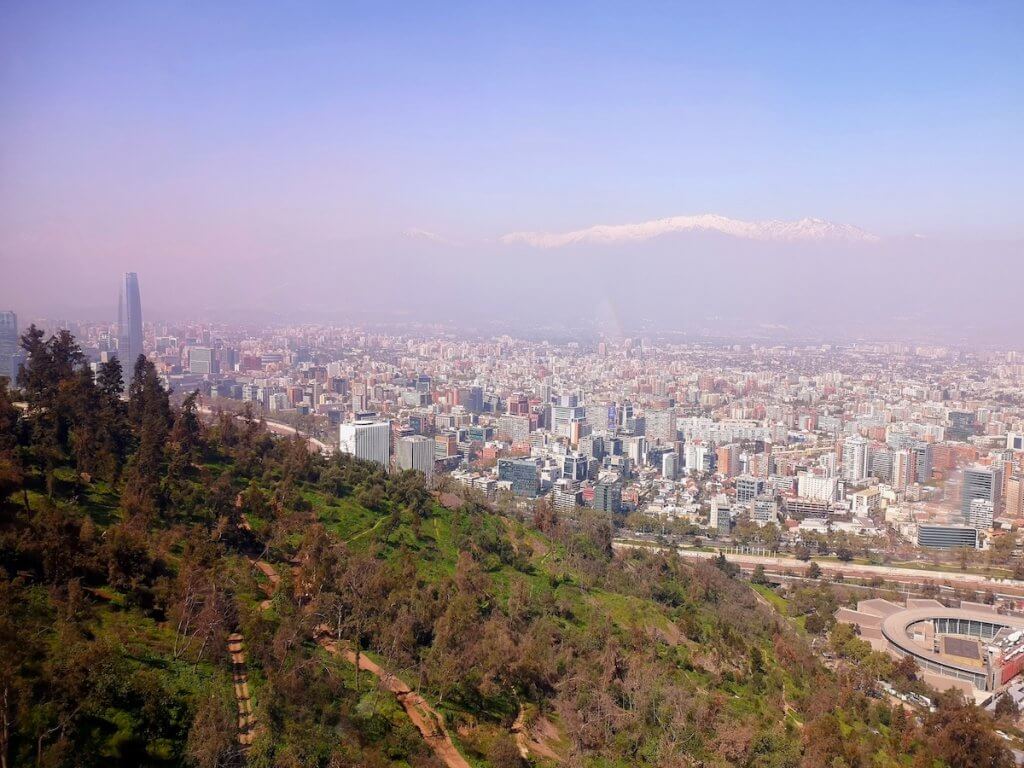
Day 26-27: Santiago – Valparaiso -Viña del Mar – Santiago
Spend a day or two in Valparaiso, a UNESCO World Heritage Site known for its colorful buildings, street art, and the largest port in Chile. You can get to Valparaiso from Santiago by a direct public bus, taxi, or a tour. The driving time is approximately 2 hours depending on the traffic. Don’t miss to check out Viña del Mar which is located between Valparaiso and Santiago. It is a resort town where locals spend their weekends and holidays. Here you can find the same sculpture as on Easter Island but a much smaller version.
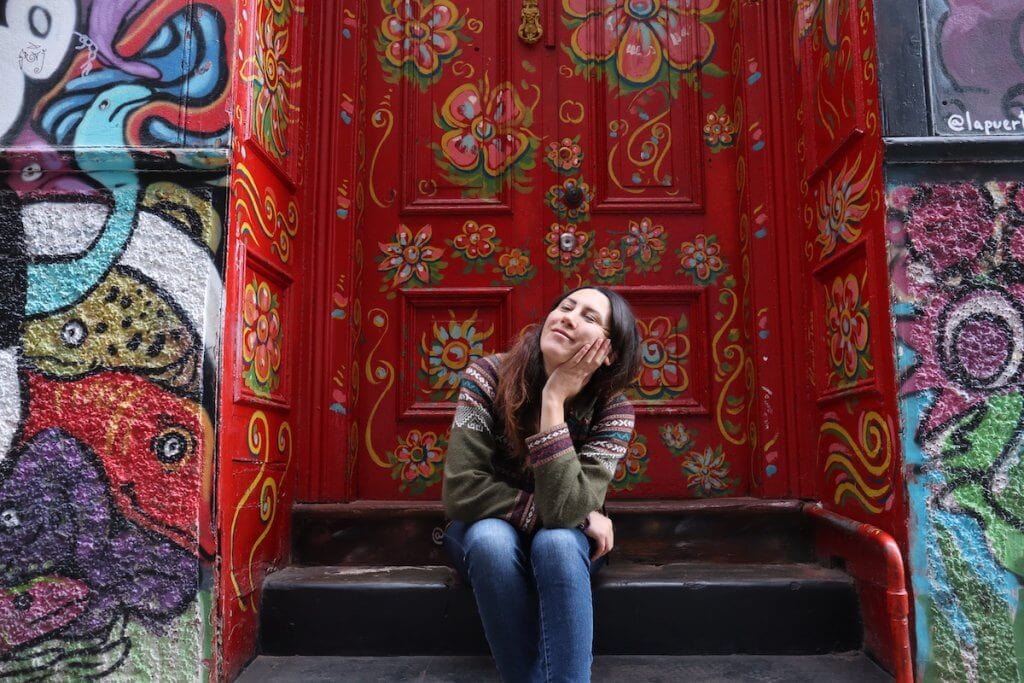
Day 28: Santiago Departure
Congratulations! You accomplished your epic South American journey and it is sadly time to head back home. After a few days of being jet-legged, you will slowly go back to normal life and your normal daily routine.
Disclosure: This article may contain affiliate links. If you purchase something through them, I may earn a small commission at no cost to you. It’s a win-win for both of us and helps to keep this content free.

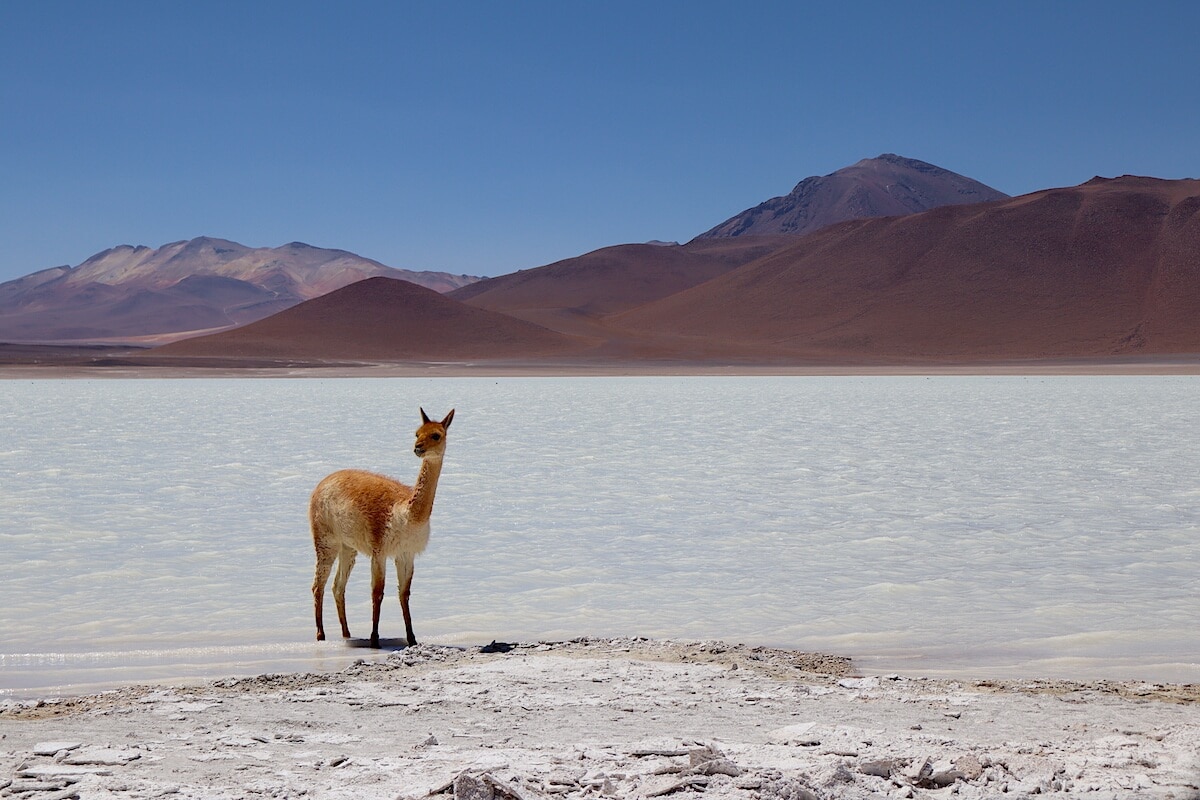
Excellent post 👏